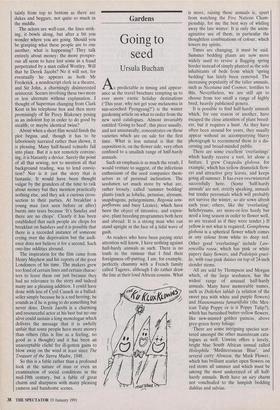Gardens
Going to seed
Ursula Buchan
As predictable in timing and appear- ance as the travel brochure tempting us to ever more exotic holiday destinations (`This year, why not get your melanoma in sun-scorched Pyongyang?') is the winter gardening article on what to order from the new seed catalogues. Almost invariably entitled 'Going to Seed', this piece usually, and not unnaturally, concentrates on those varieties which are on sale for the first time. What is less natural is that the exposition is, on the flower side, very often confined to a smallish range of half-hardy annuals.
Such an emphasis is as much the result, I would venture to suggest, of the infectious enthusiasm of the seed companies them- selves as of personal inclination. The seedsmen set much store by what are, rather loosely, called 'summer bedding' plants (such as lobelia, petunias, alyssum, snapdragons, pelargoniums, Begonia sem- perflorens and busy Lizzies), which have been the object of intensive, and expen- sive, plant breeding programmes both here and abroad. It is a strong man who can stand upright in the face of a tidal wave of gush.
As readers who have been paying strict attention will know, I have nothing against half-hardy annuals as such. There is no truth in the rumour that I find their foreignness off-putting. I am, for example, perfectly chummy with a French family called Tagetes, although I do rather draw the line at their loud African cousins. What is more, raising these annuals is, apart from watching the Five Nations Cham- pionship, for me the best way of whiling away the late winter. It is only the unim- aginative use of them, in particular the thoughtless combinations of colour, which lowers my spirits.
Times are changing, it must be said. Summer bedding plants are now more widely used to revive a flagging spring border instead of simply planted as the sole inhabitants of beds from which 'spring bedding' has lately been removed. The increasing popularity of the taller annuals, such as Nicotiana and Cosmos, testifies to this. Nevertheless, we are still apt to choose from too small a range of highly bred, heavily publicised genera.
It is possible to find half-hardy annuals which, for one reason or another, have escaped the close attention of plant breed- ers, but it requires a hunt. As they have often been around for years, they usually appear without an accompanying blurry photograph to recommend them to a dis- cerning and broad-minded public.
There are some excellent 'everlastings' which hardly receive a toot, let alone a fanfare. I grew Craspedia globosa, for example, which has yellow drumstick flow- ers and attractive grey leaves, and keeps going all summer. It has even overwintered successfully here. (Some 'half-hardy annuals' are not, strictly speaking, annuals but tender perennials which will probably not survive the winter, so are sown afresh each year; others, like the 'everlasting' helichrysums, are more-or-less hardy but need a long season in order to flower well, so are treated as if they were tender.) If yellow is not what is required, Gomphrena globosa is a spherical flower which comes in any colour from white to deep red. Other good 'everlastings' include Law- rencellia rosea, which has pink or white papery daisy flowers, and Podolepis graci- lis, with rose-pink daisies on top of 24-inch slender stems.
All are sold by Thompson and Morgan which, of the large seedsmen, has the widest range of unusual half-hardy annuals. Many have memorable names, such as Dolichos lablab (a relation of the sweet pea with white and purple flowers) -and Hunnemannia fumaritfolia (the Mex- ican Tulip Poppy or is it Poppy Tulip?), which has burnished butter-yellow flowers, like new-minted golden guineas, above grey-green ferny foliage.
There are some intriguing species scat- tered amongst the other mainstream cata- logues as well. Unwins offers a lovely, bright blue South African annual called Heliophila 'Mediterranean Blue', and several carry Alonsoa, the Mask Flower, which has brilliant scarlet open flowers on red stems all summer and which must be among the most underrated of all half- hardy annuals. Both have an airy charm not vouchsafed to the lumpish bedding dahlias and salvias.


















































 Previous page
Previous page